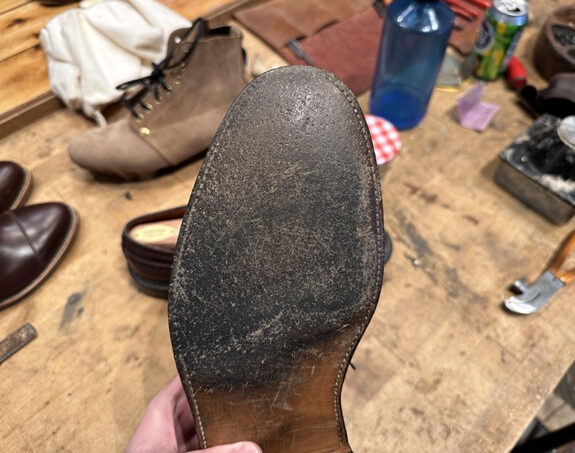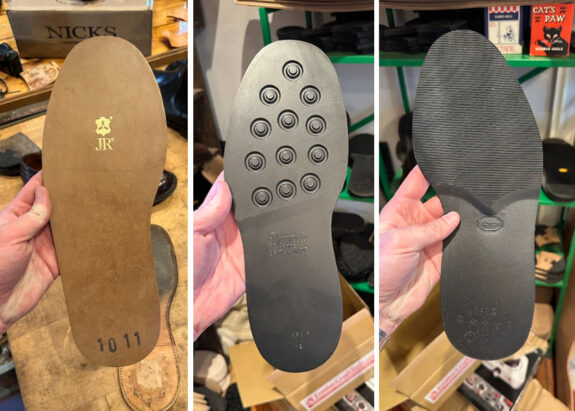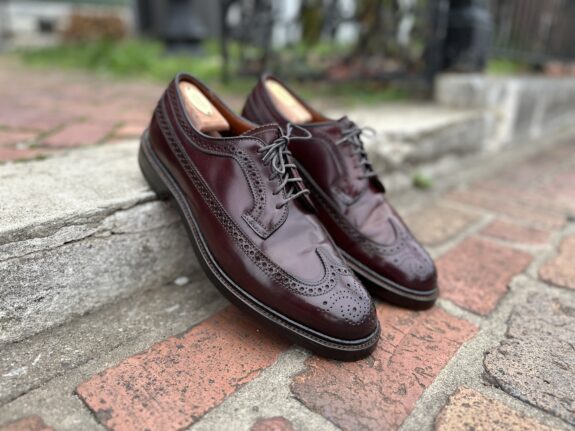Heads up: Buying via our links results in us getting a commission (not always, but just about), which helps keep the lights on around here. We also take your privacy rights seriously. Head to learn more.
About the Author: Adam Terry is a thirtysomething salesman in the heating and manufacturing industry. He enjoys bourbon, boots, sneakers, denim, and working on his dad bod father figure.
Editor’s Note: Dappered paid for the work on Adam’s footwear, and we appreciate understanding our policy of no pay-for-play. . We write the posts. No one else. .
Over the past few years, I’ve been making a concerted effort to buy fewer, but better things and to take better care of the stuff that I do buy. For example, I picked up a suit brush and a few suit cover bags from to help keep my suits fresh and to protect them from dust, moths, etc. I started folding my sweaters and knits instead of hanging them up (those shoulder bumps are terrible!), placing them neatly in some bins I picked up from Target. I also make an effort to sit down semi-monthly to clean, condition, and brush or polish my shoes and boots. When I have the time to spare (sans child), I’ll make an afternoon out of it by putting on a chill Spotify playlist, pouring myself a small glass of whiskey, and setting up a little assembly line station at my desk to process through each pair to fix ‘em up and address their needs. It may sound silly, but I enjoy the process and find it relaxing. It’s my version of self care. Sole therapy.
Adam’s Alden longwings getting recrafted by in Nashville.
This is a high quality, local shop. Options, pricing, etc. will vary.
But to over-simplify, this is what “recrafting” means for Goodyear welted shoes.
As we get older and mature a little bit, we start to realize that we should be taking better care of the things that we buy that bring us joy. This includes our beloved shoes and boots. I’d wager a majority of us Dappered readers have invested in Goodyear welted shoes and boots at some point in our journey up the menswear mountain, but I suspect a lot of guys haven’t had a pair refurbished before. I’d be willing to bet that a lot of guys simply throw away or donate their old pairs when it’s time to have them recrafted because the process sounds costly and daunting. So, we’re walking you through the process of getting your Goodyear welted footwear serviced.
Why?
When you buy Goodyear welted shoes or boots, you’re investing in a pair that’s supposed to be higher quality and longer lasting. In theory, you’ll enjoy wearing this pair so much that you’ll eventually wear through the outsole and heel. That’s OK, because these are resoleable! You’ll take them to a local cobbler and have them fixed for less than the cost of a new pair. Right?

Adam’s shoes before their service.
Well, that’s what the media and marketing folks will tell you. The truth is that a Goodyear welt is simply one method of constructing a shoe; these days, it doesn’t speak to the quality of the shoe’s materials, the facility’s craftsmanship, or the pair’s long term viability. How useful is a Goodyear welt if your boot’s upper leather or lining is too thin and wears out after six months? What if those cheap “comfort foam” insoles in your Oxfords collapse and compress into layers of hardtack? What happens when your style or taste evolves and you’re no longer a fan of a certain aesthetic? Derek Guy from once said, “Sustainability is about more than build quality; it’s about consumer behavior. In a product’s lifecycle (design -> production -> consumption), the weakest link is at the end. We discard things long before the end of their useful life simply because we become dissatisfied or disappointed with them.”
Well made shoes use repairable/replaceable components.
You don’t buy a new car when your tires or shocks are worn. Same thing with good shoes.
Thinking sustainably, it would be more frugal to buy fewer, but higher quality items. In this vein, spend good money on products that are made well and can be repaired or refurbished instead of being tossed out. Spend good money on items that lean more conservative or classic in design, so that they remain in style for many years, won’t look out of place for most people, and are easy to wear with a variety of outfits. For example, these longwing bluchers and cap toe boots are very versatile and can be dressed up or dressed down for many different occasions. This doesn’t mean you have to spend a fortune to get something nice, but it’s important to note that there does seem to be a demarcation that separates the “cheap” fashion shoes and those that are actually worth spending your money on, in terms of overall quality. For brevity, let’s draw a $200 cost threshold in the proverbial sand. If you’re accustomed to buying new shoes or boots that cost less than $200, the fees and wait time for a refurbishing service will more than likely outweigh the cost and simplicity of ordering a new pair. The exceptions to the rule would be for high quality pairs that you scored at a significant discount or pairs that have sentimental value.
A good cobbler will have lots of options.
Generally speaking, if you’re spending $250-300+ on a pair of new Goodyear welted shoes or boots, you’re probably getting higher quality materials such as finer grade leathers, more durable leather and cork internal components, more precise stitching, a wider selection of designs, a higher number of lasts and sizes, and overall a better product that’s worth saving.
When is the best time?
So, how do you know when it’s time to get your shoes repaired? Generally speaking, you’ll start to notice something different about your shoes as they wear over time. Depending on your specific shoes, the materials and mode of construction, and your wear habits, notable wear patterns can be seen in as little as a few months or it might take years before you notice anything drastic. In any case, check for excessive wear during your regular cleaning regimen.

Most will know that it’s time for a repair job when a pair of favorite shoes or boots
are no longer as comfortable as they once were.
Traction, cushioning, and shock absorption may all have withered with time and use.
For those of us with uneven gaits, you might start to notice that your heels or soles are beginning to wear more on one side or the other, depending on if you pronate or supinate. If you tend to drag your heels like I do, you’ll see those wear patterns develop on the rear corners of the heel blocks (this is why they make dovetail heels!). For most of us, we’ll know that it’s time for a repair job when we notice that our favorite shoes or boots are no longer as comfortable as they once were. This is usually because the soles have worn down in thickness, giving us less traction, less cushioning, and less shock absorption. Have you ever felt like your dress Oxfords have paper thin soles and you can feel every grain of sand or cookie crumb on the floor? Maybe you’ve worn your favorite loafers so much that you’ve actually worn through the outsole, developing a hole, which can let moisture or dirt inside? Yeah, it’s time you take ‘em to a cobbler and get them repaired before they fully disintegrate. No one wants to pull at work or on a date.
Finding a Cobbler
Finding a knowledgeable, experienced cobbler can be challenging. A lot of folks simply ship their kicks back to the factory for the routine service and that’s perfectly alright. Some big name brands , while other brands like Chippewa outsource theirs to a centralized shoe repair factory. It’s important to note that these repair services can be limited in scope of what’s available, they can have longer lead times (4-8 weeks!), but they may be cheaper than an independent shop if you’re on a budget.
A good cobbler is like a good tailor.
They extend and enhance the life of your stuff.
On the flip side, there are a bunch of independent cobblers out there who would love to earn your business. These smaller shops tend to do better, more consistent work and can usually get the job done faster if you’re working with a time crunch. Many of these shops also have a wider bandwidth of available options and extra services if you’re looking to change up the build or design of your shoes or need more complex repairs. All of this comes at a cost, though, so be prepared to spend a bit more if you want to get all fancy.
At an independent cobbler in Nashville.
Many thanks to them for letting Adam come in for a field trip.
A lot of us shoe nerds recognize that cobbling is somewhat of a dying art; like most of the other skilled trades, it’s not exactly a glamorous or highly lucrative business, so very few take up the venture. Those that do tend to be enthusiasts who turned their hobby into a side hustle, which inevitably flourished into a real business because they have the passion for it and pay a high level of attention to the details. I highly recommend finding an independent cobbler if you can.
The Model K sole stitcher at
When I went searching for a local cobbler to repair my Aldens, I used , which helped me find in Nashville, TN. Grant and Isaac are the definition of artisanal craftsmen. These two spent years as apprentices in another local shop (who I had used in the past, to lackluster results) before branching out on their own to specialize in the restoration, repair, and customization of high quality footwear. I was lucky enough to spend an afternoon with them, watching them work on various shoes and boots while “nerding out” and discussing the different options and design details that I wanted for my Longwings. They can do it all, from simple heel replacements to full blown bespoke engineer boots. If you’re in the market for a cobbler, I highly recommend Unsung House. Grant and Isaac do high quality work, they offer a ton of options/services, their prices are fair, and their communication is excellent.
Discussing your options – repair, replace, or refurbish?
So, you’ve decided to get your favorite pair refurbished and you’ve found a cobbler to do the work. Let’s break down a pair of the most common repair jobs and what they include. Note – shoe repair is a skilled labor service, so every shop will be a little different and prices will vary. Like getting a haircut, don’t expect that the cheapest or most expensive options will be the best. Also, be aware that the turnaround times can vary from a few weeks to a few months, too.
Just a few of the services Unsung House offers.
Local cobblers often offer more services compared to big-brand,
through-the-mail recrafting services.
The simplest and cheapest option is a straightforward repair job. These are the options before things get serious:
- If the heel block has been worn down, but the soles are still doing alright, you can have the heel base and toplift replaced for ~$40-60.
- If you have leather outsoles, rubber sole guards (aka Topys) can be added for ~$40-50. Some cobblers include basic conditioning and polish with this service.

The many parts of a heel.
Heels often wear faster than the soles.
The other most common service is a full resole, or “standard” recrafting package…
This service includes replacing the heels (toplifts and bases), outsoles, leather welts, and cork in-lays. Most cobblers include cleaning and conditioning or refinishing the uppers with this tier. Prices will vary from ~$100-$200+ depending on what options are chosen or what other services are needed.

“Old soles” indeed.
Here’s a list of “standard” recrafting packages from various brands and their turnaround times:
- (3-4 weeks)
- (4-6 weeks)
- (4-6 weeks)
- (6-7 weeks)
- (4-6 weeks)
- (6-8 weeks)

Soles are off, showing the cork midsole and shank within.
Options and Upgrades
If you’re looking to change up the design or enhance the usability of your boots or shoes, a full service cobbler like Unsung House can offer you a plethora of upgrades and options. It’s like the shoe version of The Cheesecake Factory menu up in here! They have over a dozen different outsole options, ranging from “house” leather to a handful of Vibram lug sole options. Fancy a vintage style corded rubber sole with actually vintage Cat’s Paw heels? You can have those. Here are a few options that I’d recommend, based on some common wear patterns.

Leather. Studded Dainite. Grippy Vibram.
Sole options are often up to you.
- If you routinely wear out your combination leather and rubber heels faster than the rest of your shoe soles…
Look at upgrading to a rubber heel toplift or a full rubber heel. Something like a Dainite or Vibram toplift will be thin and won’t detract too much from a dressy Oxford shoe. A full service cobbler can also rebuild your heel block , replacing the cheaper leather fiberboard or paper cardstock layers that are typically used to cut costs. - If you wear leather soled shoes on rough and abrasive surfaces like asphalt, aggregate, or you live in an area that routinely sees salted sidewalks and roads…
I’d highly recommend a rubber sole guard. Topy and Vibram are two brands that offer thin, but durable rubber soles that help extend the life of your shoe’s soles and add some much needed traction on slippery surfaces. - If you notice that the tips of your soles are wearing out faster than the rest of the soles…
Your gait may be causing you to strike the floor primarily with the front of your foot. that sit flush with the sole will help mitigate this excessive wear and add some durability.
Recrafting complete. New guts, new heels, new soles,
metal toe plates, a cleanup/polish, etc.
If you really want to get wild, you can have a good full service cobbler . Have them swap the OEM leather outsole and combination heel over to a Vibram 269 “Western” rubber sole and heel toplift for more grip, a slightly taller stance, and an overall more casual and usable aesthetic. As you can guess, changing up major details like this is totally possible but more labor intensive and requires some serious skill. Expect to shell out some cash for a conversion project like this.
- For a video on the restoration of my Alden x J.Crew longwing bluchers, .
- For a video on the restoration/conversion of my Alden x J.Crew cap toe boots, .
Ready for many, many more miles of wear.
Wrap it Up
Over the course of this post, we touched on buying fewer, but higher quality things and taking better care of those things so that they last longer and are worth refurbishing. That’s both frugal and sustainable. We talked about how to know when it’s time for a repair and how to find a skilled cobbler in your area. We discussed a handful of different repair options and upgrades, their associated costs, and the potential turnaround times for those services. We covered a lot in this one, so whether you’re a fresh college graduate looking for your first pair of dress Oxfords for the workplace, or you’re a V-Cleat Veteran looking for some information for your next “50K service”, I hope we’ve shed some light on the process from a “shoe recrafting 101” point of view. Cheers!
